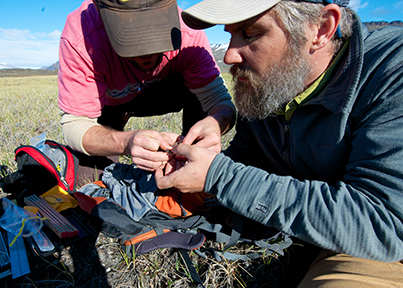
Human mediate changes in landscape have impacted many species throughout the world. Our research addresses how those changes affect wildlife, primarily at the population and species level. Combining knowledge of geographic distribution and ecology, historic and contemporary, we can preserve natural systems by identfying those factors important for maintaining viable populations such as habitat requirements, behavioral limitations, breeding system, seasonal movements, and evolutionary history.
Current research primarily addresses conservation issues related to birds, specifically grouse (Phasianidae) and birds of prey (Falconidae, Accipitridae, and Cathartidae)
We use genetic methods as a tool to identify patterns among populations such as connectivity or gene flow, levels of inbreeding and genetic diversity, population size, and local adaptation. For example, our research has identified factors important for minimizing inbreeding and improve population management using genetic approaches among six endangered species (Attwater’s Prairie-chicken, Tympanuchus cupido attwateri; Aplomado Falcon, Falco femoralis, Oriental White-backed Vulture, Gyps bengalensis; Long-billed Vulture, G. indicus; Slender-billed Vulture, G. tenuirostris; Great Green Macaw, Ara ambiguus) and two species of conservation concern (Orange-breasted Falcon, Falco deiroleucus; Military Macaw, Ara militaris), all of which are currently held in captivity or highly managed in the wild. We are also using data generated from next-generation sequencing technologies to investigate how landscape features influence Bobwhite Quail (Colinus virginianus) local population connectivity in north Texas.
We also apply phylogenetic methods to better understand the evolutionary relationships among species to help prioritize conservation efforts. This research includes both local and global distributed taxa with important findings that provide a much clearer understanding of evolutionary relationships and their associations with the environment. Recent work has focused on the prairie grouse complex (Tympanuchus spp.), falcons (Falconidae), and new world vultures (Cathartidae). Our most current projects are using next-generation sequencing technologies to generate whole or reduced-representation genome datasets (i.e., ddRADseq) to investigate phylogenetic relationships and lineage specific genomic patterns.
We often use tissue samples collected from contemporary populations. However, due to difficulties in obtaining adequate sample sizes or the inability to collected rare or extinct taxa, we also employ musuem specimens for assessing phenotypic and genetic variability. Some of our projects would not have been possible without access to museum specimens, further demonstrating the absolute importance of natural history collections in our ongoing efforts to inventory biodiversity and aid conservation efforts.
Please visit the publication page for further information concerning our research projects
